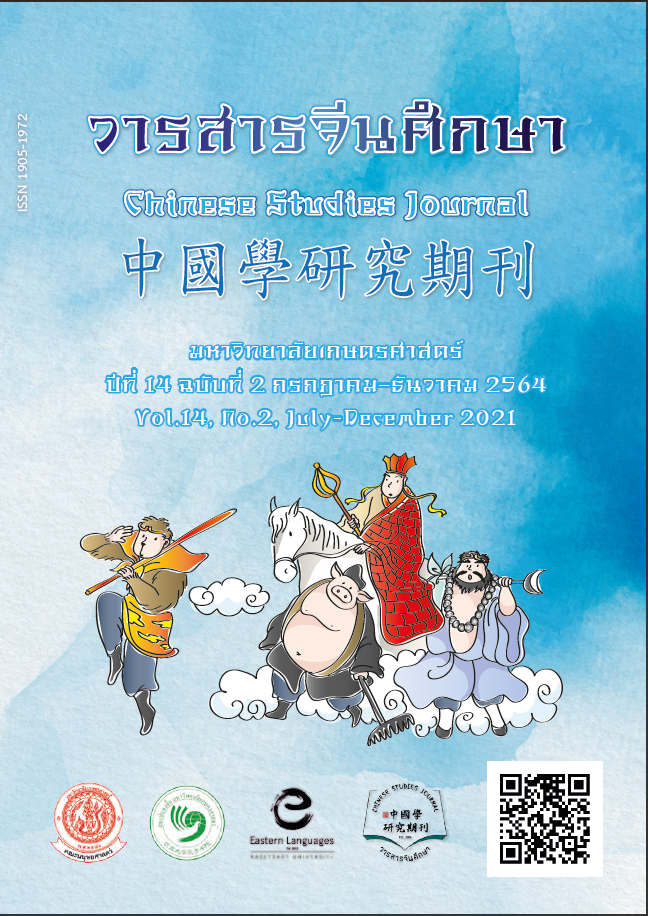Naga Images in Thailand’s Folktales
Main Article Content
Abstract
Naga, the guardian of Triratna, dominates the waters, and is an important cultural image of Thailand, as well as an auspicious symbol of ordinary life. This paper used nine folktales of Thailand as texts for exploring the Naga images. Results of this paper show: (a). The Naga images of Thailand folktales can be divided into two types: images of Buddhist stories and local stories. The main difference between the two types is Naga's behavior after converting into Buddha. (b). There are two types of Naga images reflected by two distinct cultural systems. One is Buddhism, and the other is indigenous serpent worship. The findings also imply that serpent worship probably existed before Theravada Buddhism came into Southeast Asia. It means that the Naga image of Thailand is the result of the long-term integration of local culture and foreign culture and is not entirely affected by Indianization.
Article Details
ผลงานทางวิชาการที่ลงตีพิมพ์ในวารสารจีนศึกษา มหาวิทยาลัยเกษตรศาสตร์ เป็นลิขสิทธิ์ของผู้เขียนหรือผู้แปลผลงานนั้น หากนำลงในวารสารจีนศึกษาเป็นครั้งแรก เจ้าของผลงานสามารถนำไปตีพิมพ์ซ้ำในวารสารหรือหนังสืออื่นได้โดยมิต้องแจ้งให้ทราบล่วงหน้า แต่หากผลงานที่ได้รับพิจารณานำลงในวารสารจีนศึกษา เป็นผลงานที่เคยตีพิมพ์ที่อื่นมาก่อนเจ้าของผลงานต้องจัดการเรื่องปัญหาลิขสิทธิ์กับแหล่งพิมพ์แรกเอง หากเกิดปัญหาทางกฎหมาย ถือว่าไม่อยู่ในความรับผิดชอบของวารสารจีนศึกษา มหาวิทยาลัยเกษตรศาสตร์ ทั้งนี้ ความคิดเห็นต่างๆ ในบทความเป็นความคิดเห็นส่วนตัวของผู้เขียน ไม่เกี่ยวกับกองบรรณาธิการวารสารจีนศึกษา มหาวิทยาลัยเกษตรศาสตร์
References
刀承华:《佛教对傣泰民族民间故事的影响》,《中央民族大学学报 (哲学社会科学版)》2007年第2期,113-118页。
傅光宇:《《罗摩衍那》在泰北和云南》,《民族文学研究》1997年第2 期,39-45页。
胡绍宗:《“跃进农民画”:乡村社会建设中的诗性表达》,《民族艺术》, 2019年第1期, 148-155页。
金荣华:《民间故事论集》, 台北市:三民书局, 1997 年。
刘宗迪:《故事的背后是历史—对两组闽西传说故事的民俗学研究》, 民族文学研究》, 2000 年第4期, 78-83页。
宋立道:《从印度佛教到泰国佛教》, 台北市:东大出版社, 2002 年。
王松:《傣族诗歌发展初探》, 昆明:中国民间文艺出版社出版(云南版), 1983年, 206-223页。
杨建军:《论东南亚回族华人文学的旅行书写》,《民族文学研究》, 2017年第 1 期, 164-169页。
张雅粱:《泰国东北那伽民间文学与无形文化资产》,《艺术学报》2018年 第102 期,105-134页。
郑土有:《民俗场:民间文学类非遗活态保护的核心问题》,《长江大学 学报(社会科学版)》, 第40卷第3期, 2017年, 20-24页。
中华电子佛典协会编辑:《CBETA佛典协会集成》, 台北市:中华电子佛典 协会出版, 2014年。
Bamrungphak, Sowit. “Legendary Serpents and Buddhist Existence: Phya Ngu-Yai,Phya Nag, Phya Luang, Phya Mang-Kon,” (=เป็น อยู่ คือ : พญางูใหญ่ พญานาค พญาลวง และพญามังกร) Journal of Buddhist Studies, 2014, 21(2): 79-89. (in Thai)
Chang, Y. L.. “Exploring Naga Images: Textual Analysis of Thailand’s Narratives,”Journal of Mekong Societies, 2017, 13(1): 19-35.
Davis, Richard B.. Muang Metaphysics.Bangkok: Pandora, 1984.
Department of Cultural Promotion, “Draft Intangible Cultural Heritage Act,” (=ร่างพระราชบัญญัติว่าด้วย มรดกทางวัฒนธรรมที่จับต้องไม่ได้) 2013, Retrieved from http://www.siamese-heritage.org/pdf/Draft_ICH_Law.pdf, March 27, 2020. (in Thai)
Department of Cultural Promotion, Intangible Cultural Heritage in Thailand 2011 (=สยามไทยมุงมรดกวัฒนธรรม : มรดกภูมิปัญญาทางวัฒนธรรมของชาติ ประจำปีพุทธศักราช ๒๕๕๔) 2011, Retrieved from http://book.culture.go.th/newbook /ich/ich 2011.pdf. (in Thai)
Hongsuwan, Pathom. “Sacralization of the Mekong River Through Folk Narratives ,”MANUSYA: Journal of Humanities, Special Issue, 2011,19: 33- 45.
Jumsai, Sumet. NAGA: Cultural Origins in Siam and the West Pacific.Bangkok: Chalermnit Press, 1997.
Keyes, Charles F..The Golden Peninsula: Culture and Adaptation in Mainland Southeast Asia. Honolulu [Hawaii]: University of Hawaii Press, 1995.
Laomanajarern, Siripot. “ Naga: A Symbol Study Related the Indian Model,” (=นาค : การศึกษาเชิงสัญลักษณ์ตามคติอินเดีย) Journal of Damrong, 2003,2(4): 148-158. (in Thai)
Mahamakut Buddhist University (ed.). Tripitaka in Thai Translation Version. (=พระไตรปิฎกและอรรถกถาแปล), vol.58. Nakhon Pathom: Mahamakut Buddhist University, 2003a, pp.22-29. (in Thai)
Mahamakut Buddhist University (ed.). Tripitaka in Thai Translation Version. (=พระไตรปิฎกและอรรถกถาแปล), vol.57. Nakhon Pathom: Mahamakut Buddhist University, 2003b, pp.22-26. (in Thai)
Mahamakut Buddhist University (ed.). Tripitaka in Thai Translation Version. (=พระไตรปิฎกและอรรถกถาแปล), vol.64. Nakhon Pathom: Mahamakut Buddhist University, 2003c, pp.1-27. (in Thai)
Mahamakut Buddhist University (ed.). Tripitaka in Thai Translation Version. (=พระไตรปิฎกและอรรถกถาแปล), vol.44. Nakhon Pathom: Mahamakut Buddhist University, 2003d, pp.161-162. (in Thai)
Ngaosrivathana, Mayoury and Pheuiphanh Ngaosrivathana. The Enduring Sacred Landscape of the NAGA.Chiang Mai: Mekong Press, 2009.
Panda, Sasanka Sekhar. “Nagas in the Sculptural Decorations of Early West Orissan Temples,”Ohrj, 2004, XlvII(1): 16-37.
Phan, Anh Tu. “The Signification of Naga in Thai Architectural and Sculptural Ornaments,” DIALOGUE, 2016, 17(4): 154-175.
Phlainoi, Sombat. Animals of Himmapan.(=สัตว์หิมพานต์) Bangkok: Phimkham., 4th ed., 2009. (in Thai)
Phutamart, Chamaiporn. Wood Carving Patterns for Temple of Lanna in Mueang Lampang, Lampang Province.(=ลวดลายไม้แกะสลักวิหารล้านนาในเขตอำเภอเมืองลำปาง จังหวัดลำปาง) Thai Art Department, Faculty of Fine Arts, Chiang Mai University, 2013. (in Thai)
Pritasuwan, Phiraya. The Naga Decorate Buddhist Temples in Amphoe Mueang Nan. (=นาคประดับพุทธสถาน อำเภอเมืองน่าน) Thai Art Department, Faculty of Fine Arts, Chiang Mai University, 2014. (in Thai)
Saipan, Pichet, "Naga Worship" of the Mekong River Basin in Northeastern Thailand: Focusing on the Cultural Experience of Contemporary Rituals. (= . “นาคาคติ” อีสานลุ่มน้ำโขง : ชีวิตทางวัฒนธรรมจากพิธีกรรมร่วมสมัย) Master Thesis in Department of Anthropology, Faculty of Sociology, Bangkok: Thammasat University, 1996. (in Thai)
Samphan, Aree. Folktales in Thailand. (=นิทานพื้นบ้าน ตำนานท้องถิ่น) Bangkok: Khri E Thabuk, 2010, pp.80-82. (in Thai)
Tambiah, S.J.. Buddhism and the Spirit Cults in North-East Thailand. London, New York: Cambridge University Press, 1970.
Nathalang, Siraphon. ““Creative Folklore”: A Review of Its Social Context and Related Concepts,” (=“คติชนสร้างสรรค์”: บทปริทัศน์บริบททางสังคมและแนวคิดที่เกี่ยวข้อง) Journal of Letters, 2013, 42(2): 1-74. (in Thai)
Wongthes, Sujit. Naga in History of Southeast Asia (=นาคในประวัติศาสตร์อุษาคเนย์). Bangkok: Mati Chon, 2003. (in Thai)
Woodward, Hiram. The Art and Architecture of Thailand. Leiden; Boston: Brill. 2nd ed., 2005.


